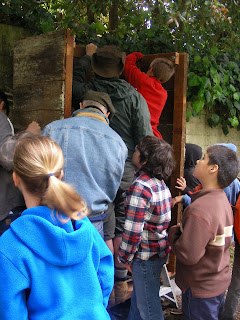Spring and summer in the gardens
Welcome back to school!
The school garden keeps turning up potatoes! Even in late August, in beds I thought had long been cleaned out by eager third grade diggers, I keep finding more and more potatoes waiting under the soil. I harvested several of the darkest purple variety. Their starchy insides were deep purple with clouds of bright white here and there. On another potato note, back in June at St. Anne’s the First Grade finished work on the new three-level terrace near the palm tree. With the help of a few dedicated parents, the children worked for weeks to terrace a small hillside - laying stones, moving soil, and then mulching it with compost. When finished, every first grader planted a variety of fingerling potato. These are small potatoes, shaped long and slender like fingers. Those potato plants went wild over the summer and are now dying back-just in time for the 3rd grade harvest dinner this fall!
Peas are another constant in our San Francisco gardens. They like our cool weather and grow prolifically along a string or chicken wire lattice. We plant mainly the sugar snap variety, the kind where you can pop the whole pod in your mouth, no need to shell them unless you let them sit too long on the vine. We interspersed sweet peas with the edible peas this year for a burst of color and sweet scent. It’s important to build different trellis structures for peas and beans: peas like to grab on to twine or small stems of other sturdy plants with their tendrils. The trellis should have twine or wire running both ways, horizontal and vertical. Beans, on the other hand, don’t have tendrils. Beans like to follow a single piece of twine vertically, as if they’re climbing a fireman’s pole. They attach by twisting their stalk around the vertical support. Lateral wire lines would only get in the way of their spiraling action.
At the end of the school year each kindergarten class put in a tomato plant, complete with a very dramatic, slow-release fish head fertilizer courtesy of Bryan’s in Laurel Village. These tomatoes are doing well. We also planted half a dozen in pots on the patio for St. Anne’s residents to enjoy. The cool spring caused many of my tomato seedlings to develop an illness called blight. Blight is very common in cool, wet weather. Luckily none of them had gone in the ground at this point, so I was able to cull the infected starts. It was actually a helpful way for me to see which varieties were most resistant. The most robust varieties were Stupice, Black Plum, Northern Delight, and Camp Joy. These are all cherry to small in size, the most likely size to ripen in our SF summers.


We ended our year in the gardens at St. Anne’s and Laguna Honda with our thank you parties for the residents and staff. At Laguna Honda the high school students helped to wheel out close to twenty residents for an afternoon of animal viewing and snacks. At St. Anne’s, I invited the residents and staff of St. Anne’s and the third grade families who’ve helped so willingly in the garden these four years. We enjoyed food from the garden, garden-themed art by the residents, and the beautiful sounds of Ms. Christofferson playing her harp.
Just before school let out we secured a honeybee swarm for our new hive across the street from St. Anne’s at Tad Kinney’s home (Sam gd 6, Liza gd 5). The swarm originated in the backyard hive of a Noe Valley bee keeper. My daughter and I drove the swarm across town to Tad’s with the bees contained in a swarm box, basically a sealed card board banker’s box with some mesh ventilation holes. Rinat Abastado, our long time beekeeper, installed them with a gentle shake into their new top bar hive. As Rinat and her family moved north this summer to Sebastopol, Karmin Guzder has happily agreed to take over bee keeping for the hive. Ms. Guzder and I visited the hive in late June and were delighted to discover thirteen bars full of beautiful snow white comb containing drone and worker cells, as well as capped honey. The bees are thriving. 
In August, Ms. Guzder and I thought we spied a queen cell on the bottom corner of the comb. Sure enough, days later the bees swarmed and with quick phone calls we were able to find a bee keeper to capture the swarm while it hung in a tree next door to the Kinney’s. That swarm now resides in our Golden Hive at Laguna Honda where they have settled in well despite the foggy weather of late. We feel so lucky to have two hives from the same robust bee family!

I want to extend my gratitude to all my 2010-11 garden volunteers and drivers at St. Anne’s and Laguna Honda. There were over 35 of you who gave your time and energy to the Urban Farm and Garden Program and I am deeply grateful. Thank you. Also, a special thanks to our generous host facilities: St. Anne’s and Laguna Honda Hospital. Our school could not offer these programs without these partnerships!
Please contact me if you’d like to garden with us this fall!

